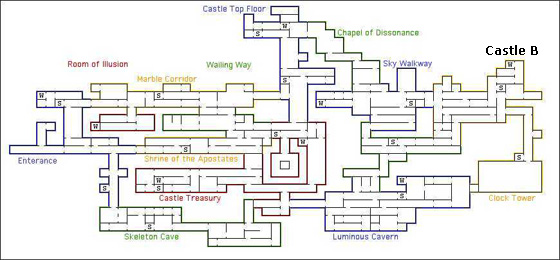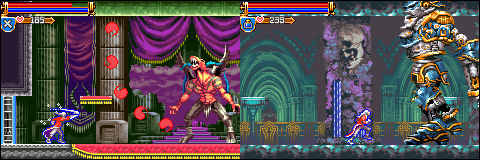Castlevania: Harmony of Dissonance – Castle Layout and Ability “Stringing”
November 2nd, 2010
My experience with Harmony of Dissonance can be summarised like this: it took me about a month of on-and-off play to complete Harmony of Dissonance, whereas I beat Aria of Sorrow in 3 days of solid play. My playtime was drawn-out in Harmony of Dissonance because of numerous road blocks which brought my playtime to a standstill.
Harmony of Dissonance‘s castle, as you can see from the map, is a muddle of interconnected subsections (marked by their text labels) without a central hub to string players neatly from the end of one area to the start of another. Subsections effectively act as routes to other subsections bottlenecking progress and creating large amounts of needless backtracking. That is, if you need to get from the Sky Walkway to the Entrance, you must backtrack through 3-5 subsections depending on which route you take. It’s also very difficult for the player to mentally compress this amalgamation of play zones into a coherent order.
The player travels from the entrance to the (uppish) left of the screen to the point labelled “castle b” (they teleport between the 2 masses of areas), then back underneath to the entrance and finally to the central box. At any point in the game there is more than one path to take. This number doubles at the “Castle B” point on the map where the entire castle is duplicated and the player can switch to the slightly modified palette-swap version through special portals. Because of the large number of avenues and potential dead-ends for players, Harmony of Dissonance ought to utilise a combination of techniques to gesture players towards the right path.
The best measure for guiding the player in a Metroidvania game is to create a baiting system around the player’s not-yet-acquired abilities. You do this by starting the player off with only basic functionality, dropping interaction markers for not-yet-acquired abilities throughout the environment and then finally coughing up the abilities necessary to interact with said interaction points. The interaction markers (a grapple point, a platform that’s just too high to reach) plant seeds in the player’s mind which they mentally flag down, then once they obtain a new ability (grapple beam, double jump) and draw the connection between the new ability and the interaction point, a “click” goes off in their brain. They’ve done it! The player thinks that they are so smart for figuring it all out and rushes to where the interaction marker is (conveniently, the next part of the game) with haste. This is a tried and true design element of Metroidvania games.
Harmony of Dissonance only has 3 obtainable abilities to limit the player’s progression: Lizzard’s tale (slide), Sylph Feather (double jump) and Griffith’s Wing (high jump). Considering the game’s size, 3 abilities is far too few to string the player from one part of the game to another. Furthermore, there’s a very lax reliance on these already too few abilities. They’re only ever properly needed a few times throughout the whole game. Once at the junction point to the next area and then maybe a few times after that. Because there are so few interaction points in Harmony of Dissonance (and the nature of the upgrades mean that they can’t be made explicitly clear, ie higher platforms as opposed to a clearly defined grapple point), this stringing dynamic is hardly at all in play. An exception to this is the suggestion of a raised room on the exterior pathway to the castle, a seed that plants itself deep in the initial instances of the game.
Because the number of abilities is so few, Harmony of Dissonance uses some peripheral, inventory items to replace abilities as limiting factors. As these items are really just nothing more than added text in your menu, it’s not always easy to draw the connections between an piece of inventory and something in the environment which requires it. A key to a door is simple enough, but when a key is Maxim’s braclet and it opens a magic door, it gets tricky. And anyways, it’s easy to forget that you even have a key when you can only use it in the one instance. Other issues arise when you use a key to open a floodgate that you can’t find on the map, effectively asking the player to put the key in a random hole while the supposed flood gate opens.
Conclusion
Harmony of Dissonance demanded entirely too much of my time and patience due to a confusing left-to-right castle design and a lack of effective stringing through ability baiting. The castle connects subsections together like Lego and not to a hub-like core which reduces backtracking and unclear, overlapping design. The stringing proved weak because only a handful of abilities were used and they were stretched over the whole game. Furthermore, inventory items were occasionally used as weak replacements.
Additional Readings
Castlevania: Harmony of Dissonance (2002) – Castlevania Dungeon
Castlevania Harmony Of Dissonance : Playing As Simon Belmont, Megaman And Mario






 Game Design Companion: A Critical Analysis of Wario Land 4 - $7.99
Game Design Companion: A Critical Analysis of Wario Land 4 - $7.99 Level Design: Processes and Experiences
Level Design: Processes and Experiences Speed Boost: The Hidden Secrets Behind Arcade Racing Design - $5.99
Speed Boost: The Hidden Secrets Behind Arcade Racing Design - $5.99 Adventures in Games Analysis: Volume I - $5.99
Adventures in Games Analysis: Volume I - $5.99







